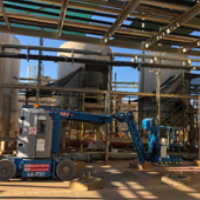 The process of extracting and processing uranium can present many challenges. Machinery and equipment are exposed to environments during production, which over time can cause damage and lead to shutdowns.
The process of extracting and processing uranium can present many challenges. Machinery and equipment are exposed to environments during production, which over time can cause damage and lead to shutdowns.
If left untreated, corrosion can lead to major consequences for large assets, such as vessels. Both on a financial level as well as environmental.
A uranium mine in Australia uses a unique extraction technology to produce high purity uranium. A planned upgrade revealed issues with the existing rubber lining of exchange vessels, critical to the extraction process.
The lining failure had caused corrosion of the steel substrate (which had continued to go unnoticed behind the rubber) and now had the potential to severely impact production and ultimately shut them down completely.
The exchange vessels measure at around 2.5m (8.2ft) in diameter and 5m (16.4ft) in height and are considered the lifeblood of their business. The process conditions meant that there was a strong chemical presence and high operating temperatures further contributing to the corrosion of the lining.
Two of the vessels were able to be viewed, due to being out of service, helping to understand the process conditions. A solution had to be presented that could offer good chemical resistance and withstand high operating temperatures.
The existing rubber internal lining had to be removed using a high temperature, ultra-high-pressure jet water operating at 150°C (302°F) and 40,000psi pressure. This stripped back the rubber lining, leaving a bare steel shell with only small amounts of rubber remaining. This was then whip blasted and any sharp angles, burrs and weld defects were identified and prepared to a minimum R5 radius suitable for coating.
Following on from the pre-surface preparation, the vessel was degreased using high-pressure water jetting at 6,000psi followed by a solvent wash using MEK before being blasted.
Before the new internal linings were applied, nozzle inserts were fitted with a stripe coat of Belzona 1391T to the circumferential welds and bracket details. Nozzle inserts manufactured using Belzona 1511 (Super HT-Metal) were initially dry fitted into the appropriate nozzle where they were then marked and cut to size before being bonded in place using Belzona 1391T. Small areas of pitting around the welds were filled at the same time and allowed to cure. After the required length of time and within the overcoat window of Belzona 1391T, the stripe coat was applied to the welds and large nozzles.
Spraying of the new internal linings began once the stripe coatings were cured. To provide a full turnkey solution without any delays, blasting of the second vessel began whilst the first vessel was being coated. The original coating was then left to cure overnight with a second coat to follow the next day. Heat was applied to the vessels to assist in providing a fast cure time and return to service.
Thanks to effective time management throughout, the overall application was able to be completed very quickly, with each vessel taking a few days to complete. The vessels gained long-term protection against corrosion and a longer service life.
https://www.belzona.com/en/index.aspx



